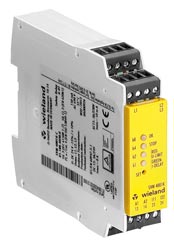
Posted to News on 27th Oct 2014, 09:17
How to use modern standstill monitors to maximise productivity
Once a risk assessment has indicated that certain safety features need to be incorporated, it makes sense to investigate which technologies can facilitate compliance. Paul Considine of Wieland Electric explains how the latest generation of standstill monitors can facilitate compliance while helping to maximise productivity.

Anyone involved in machine safety will be aware of the growing pressures to maintain maximum productivity in today's competitive markets, while ensuring compliance with legislation to ensure that safety is not compromised. For example, the Machinery (Safety) Directive 2006/42/EC puts greater emphasis on risk assessments, compared to its predecessors, and this can be onerous for those responsible.
In parallel, as the automation of production lines becomes more complex, then the associated safety systems will inevitably also become more complex. This has clear cost implications which certainly cannot be avoided completely. However, they can be mitigated by taking advantage of the new technologies that are available to reduce complexity and therefore help ease this financial burden. The key is to be aware of what is available and take advantage of it.
This principle can clearly be exemplified by reference to standstill monitors. These are a vital component in the safety systems of any process where movement of machinery poses a danger to operators or other people in the space. One of the main areas of application is the control of tumblers in electric locking facilities. In this case, access to a dangerous machine part is only granted when the machine movement no longer poses a risk for the operator.
Start with a risk assessment
Consequently, the risk assessment is vital. If the risk assessment shows that the machine will be safe when the device has stopped moving then this is an obvious application for a standstill device. In this respect it is important to note that the risk assessment will typically indicate that the machine is in a safe state when the motor has stopped, but there may be some remaining momentum after this time.
Traditionally, standstill monitors require links to external sensors that are used to detect movement, so this clearly requires a certain amount of hardwiring between the monitor and the sensors as part of the safety system installation. The complexity of the system also results in a more complex monitoring circuit.
New technologies, however, eliminate this requirement for external sensors by using a connection to the motor that measures the back-EMF voltage to detect when the motor has stopped. These monitors are suitable for use wherever the rotational movement is driven by a motor from a direct drive.
New standstill monitors are easier to install
As a result, installation of these new standstill monitors is considerably more straightforward and requires less time - all adding up to reduced cost and a simpler system.
When selecting such monitors there are a number of other criteria that it is sensible to take account of. For example, the amount of DIN rail space required is a very practical consideration, so choosing a slimmer standstill monitor will make sense if it is necessary to conserve DIN rail space in the electrical cabinet.
Other factors to take into account include the ability to adjust the threshold voltage, as it may be desirable to vary the tripping level to suit each motor, as this depends on the supply voltage. Any such monitors should also be compatible with both single- and three-phase motors and frequency converters.
It can also be useful to be able to bypass the safety circuit (as long as there are other safeguards in place) during the commissioning process.
Risk assessment software
The specification of standstill monitors is just one example of the vital role that the risk assessment plays in achieving a safe working environment. However it is also true that as many more people are now legally required to create risk assessments this procedure can become very time- and resource-consuming. Here, the principle of making use of new technologies can also be applied to make life easier. For example, there is now software available that enables modular creation of risk assessments and makes the whole process simple and quick, while ensuring compliance with the Machinery Directive (often referred to as the Machine Safety Directive).
The software uses a dynamic risk graph that guides the user to the correct risk priority number. Once a need for action has been determined the measures for risk reduction can be described. Other useful features include management of 'to do' items across companies, template management for risk reduction solutions, integrated standards management and version control.
The underlying principle here is that it really is worth taking the time to explore new technologies and innovative products that are being introduced to the market to make life easier for the machine safety sector. It is certainly time that will be well-invested.
Follow the link for more information about machinery safety products, systems and software from Wieland Electric.
Ash House, Tanshire Park
Shackleford Road
GU8 6LB
UNITED KINGDOM
+44 (0)1483 531213






























